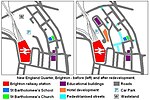Brighton

Brighton () is a seaside resort and one of the two main areas of the City of Brighton and Hove. Located on the south coast of England, in the county of East Sussex, it is 47 miles (76 km) south of London.Archaeological evidence of settlement in the area dates back to the Bronze Age, Roman and Anglo-Saxon periods. The ancient settlement of "Brighthelmstone" was documented in the Domesday Book (1086). From about 1730 it developed as a health resort. King George IV spent much time in the town and constructed the Royal Pavilion there. Arrival of the railways in 1841 helped it become a popular destination for day-trippers from London. Brighton joined Hove to form the unitary authority of Brighton and Hove in 1997, which was granted city status in 2000. As of 2017, Brighton and Hove had a resident population of about 290,885. Brighton has been described as the UK's "hippest city", "the happiest place to live in the UK", and the "unofficial gay capital of the UK".
Excerpt from the Wikipedia article Brighton (License: CC BY-SA 3.0, Authors, Images).Brighton
Kemp Street, Brighton Round Hill
Geographical coordinates (GPS) Address Nearby Places Show on map
Geographical coordinates (GPS)
| Latitude | Longitude |
|---|---|
| N 50.82838 ° | E -0.13947 ° |
Address
Kemp Street
Kemp Street
BN1 4FT Brighton, Round Hill
England, United Kingdom
Open on Google Maps










